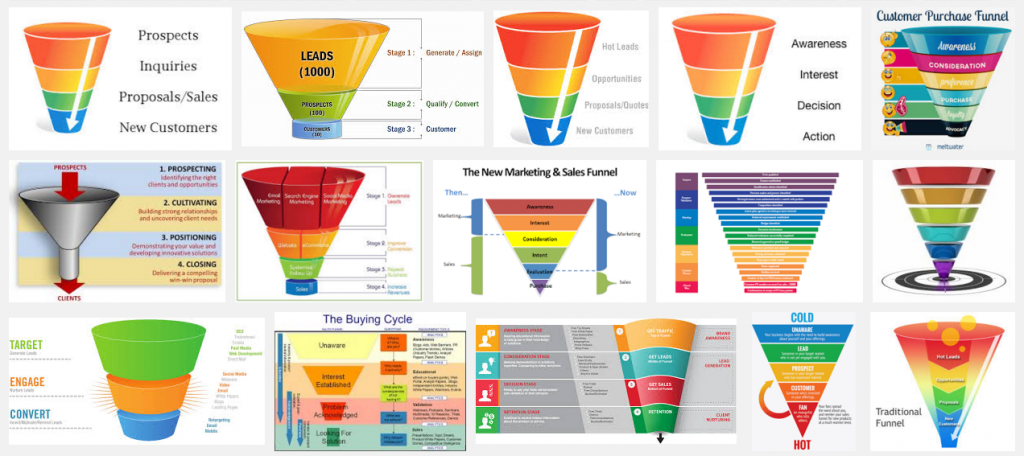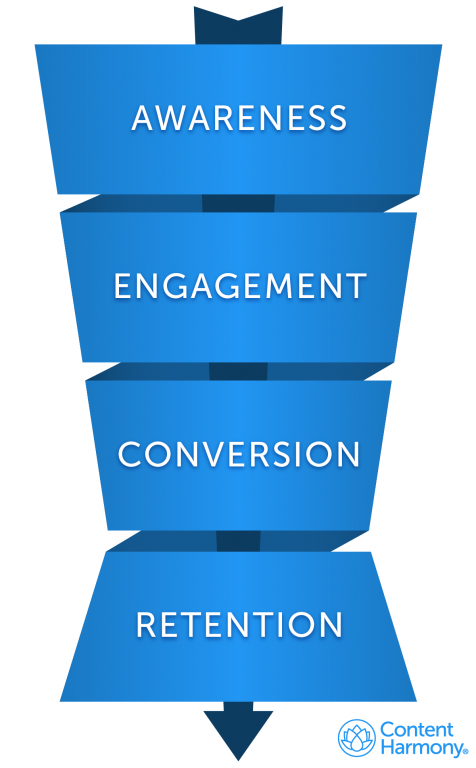I have a conceptual problem with how most marketers visualize the sales funnel.
99% of the time, they either leave out retention marketing entirely, and they visualize it in a way that makes it appear to be less valuable than it is.
The focal point for most funnels is the conversion stage, when a customer first makes a purchase with your company. Of course you want to win new customers, but it costs you 7x more to convert new leads than it does to keep a current a customer. If you’re treating each sale like a big win, but not putting any energy into retention marketing, you’re celebrating victory way too early.
Winning a new customer is great. But retaining a customer is typically easier and more valuable. Let’s take a closer look at a better way to visualize the sales funnel.
What Typical Sales Funnels Don’t Show You
Most businesses still envision their content marketing program as a sort of funnel that “leaks” unqualified leads along the way. As the name suggests, the number of prospects you start off with is always greater than the number of leads that convert into paying customers.

Take a look at Google Image results for “Sales Funnel” – they all visualize a literal funnel or ‘pizza slice’ shape.
Every sales funnel variation looks a little different—they might label sections differently than a traditional AIDA model or add some additional steps. Nevertheless, a typical sales funnel has three core stages:
Stage 1: Awareness
In the Awareness Stage, your goal is to make yourself visible to your new customers. In stage one, most of your target audience isn’t even aware that they have a need for your services—which is why your marketing is designed to build that first exposure with them.
Stage 2: Engagement & Consideration
Stage two is where your customers research their options. It’s your job to educate them on your products and services, and showcase why your solution is the best solution. Specific information on pricing, ROI, and revenue gain goes a long way toward differentiating you from your competitors.
Stage 3: Conversion
Conversion is the final stage of most sales funnels. The goal here is to land a sale, which means that you need to promote confidence in your brand. Here, you offer proof to win over customers on the brink of purchase.
These Models Are Missing A Key 4th Stage of the Sales Funnel
By the end of this process, you’ve made a sale and you can pat yourself on the back, right? Wrong. There’s one last stage, and it’s the most important:
Stage 4: Retention
We combine all post-conversion actions into a stage called retention marketing. It’s any process that encourages a customer who has made a single sale to either make additional purchases or to begin referring you. Conveniently, these tend to start with the letter R:
- Repeat or Recurring Revenue – any revenue that comes in after the first sale
- Upsell – Increases in services above the initial purchase level
- Referrals – word of mouth marketing at its best
- Reviews – public reviews of your business
In larger companies you’ll see these take the form of marketing teams dedicated to customer success, satisfaction, loyalty, word-of-mouth, and other similar subsets, but all share the broader goal of keeping and upselling current customers.
Businesses that ignore this crucial step are missing out on the most important part of their marketing campaign—Retention Marketing.
What Your Sales Funnel Should Look Like
When you focus on Retention Marketing, your sales funnel won’t look like a funnel anymore—it will look more like an hourglass.
This “hourglass funnel” widens again after conversion, until it looks more like this:

The Hourglass Sales Funnel
At the heart of every sales funnel is the desire to align your marketing and sales efforts. You want to turn visitors into leads, convince those leads to continue through the funnel, and eventually persuade them to make a purchase.
The hourglass funnel has the added benefit of showing that the crucial final step, customer retention, is actually an area for growth as opposed to diminishing value over time. By expanding back outwards, this model demonstrates that a healthy customer satisfaction and loyalty effort will grow your business, as satisfied customers evangelize your business and return for more services. New customers are then persuaded by referrals, and the whole process starts over.
The benefits of improving customer satisfaction and retention speak for themselves:
- Profits can increase by more than 25% after only a 5% increase in customer retention.
- There’s a 60-70% chance that you can convert an existing customer. With new customers, there’s only a 5-20% chance.
- Loyal customers are 70% more likely to refer your business to friends.
How To Grow The Value of Your Existing Customers
The goal of retention marketing is to increase revenue through your satisfied customers. In other words, you’re maximizing the lifetime value of your customers (typically abbreviated as LTV or CLV).
Why does this matter? Because loyal customers have been shown to be worth as much as 10x more than their first purchase and account for 80% of a company’s revenue.
You can promote loyalty and customer satisfaction a number of different ways, including:
1. Consistently Deliver Quality Services
It should go without saying, but the single most important element when it comes to purchase intent and loyalty is that your brand is always associated with exceptional quality. You want to develop satisfied customers who will tout your business—you can hardly expect that result if you consistently under-deliver.
Part of delivering a quality service is establishing a niche that you excel at. Publish content that establishes yourself as an expert in your industry, then your customers will turn to you for solutions.
2. Build A Relationship With Your Customers
Your community has the potential to be the single biggest driver of new customers. When your customers are satisfied, they’ll amplify your content on social media, and refer you to their friends.
It’s also important to respond to dissatisfied customers who reach out to you on social media. Work towards a solution with these customers and show them that you’re willing to run the extra mile to resolve their problem.
3. Encourage Repeat Purchases
Marketing campaigns aren’t just for new customers. A well-targeted email campaign or loyalty incentive program goes a long way towards winning new business from your existing customers too.
Starbucks is a great example of a loyalty program that’s working—their “My Starbucks Rewards” program, which makes payment easier and lets loyal customers win free drinks and food, now has over 10 million members. It’s a simple, but powerful incentive from a well-established brand.
4. Use Testimonials & Referrals
There are few things more persuasive than social proof. When you’ve inspired customers to believe in your brand, promote their experiences through testimonials on your website and social media pages.
You can also ask for referrals—don’t let pride stop you from reaching out to your community. Social media makes it easier than ever to share content that loyal customers will be happy to refer, and you can always run contests or promotions to further incentivize these referrals.
5. Learn From Dissatisfied Customers
When customers unsubscribe to your email campaigns or your loyalty program, don’t let them go without learning why. Find out what drove your customers to leave, and what changes or incentives you could offer that might entice them to return—this could work on more customers than you realize.
A similar lesson applies when you receive complaints—handle them as quickly and efficiently as possible. Treating complaints seriously will demonstrate that you care to your community. You can also use these as learning moments that you can turn into a blog post or FAQ to address your customers’ pain points.
Stop Referencing Broken Sales Funnels
In the digital age, the sales funnel is an imperfect model. The customer lifecycle is an effective visualization to demonstrate that customers don’t make purchases in linear steps, but not a complete replacement. The sales funnel is still a valuable way for marketers and sales teams to view the broad stages that make up that purchase process. But, as marketers, we need to use a model that represents the actual potential in the process.
✉️ Get an email when we publish new content:
Don't worry, we won't bug you with junk. Just great content marketing resources.
Ready To Try
Content Harmony?
Get your first 10 briefs for just $10
No trial limits or auto renewals. Just upgrade when you're ready.

You Might Also Like:
- The Wile E. Coyote Approach To Content Guidelines
- Content Brief Templates: 20 Free Downloads & Examples
- The Keyword Difficulty Myth
- How To Find Bottom of Funnel (BoFU) Keywords That Convert
- Bottom of Funnel Content: What Is BOFU Content & 10 Great Examples
- 20 Content Refresh Case Studies & Examples: How Updating Content Can Lead to a Tidal Wave of Traffic 🌊
- How to Create Editorial Guidelines [With 9+ Examples]
- Content Marketing Roles
- How To Write SEO-Focused Content Briefs
- The Content Optimization Framework: [Intent > Topic > UX]
- How To Update & Refresh Old Website Content (And Why)
- 12 Content Marketing KPIs Worth Tracking (And 3 That Aren't)
- 16 Best Content Writing Tools in 2024 (Free & Paid)
- How to Create a Content Marketing Strategy [+ Free Template]
- How To Create Content Marketing Proposals That Land The Best Clients
- What Is A Content Brief (And Why Is It Important)?
- How To Create A Dynamite Editorial Calendar [+ Free Spreadsheet Template]
- How to Use Content Marketing to Improve Customer Retention
- Types of Content Hubs: 5 Approaches & 30+ Examples
- How To Do A Content Marketing Quick Wins Analysis